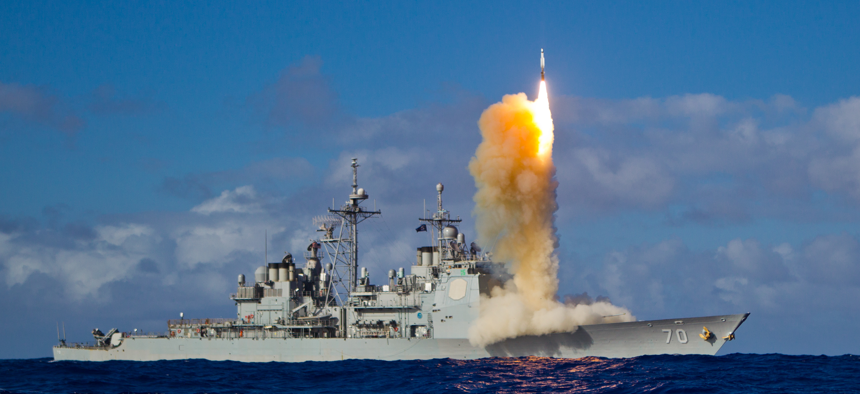
The cruiser Lake Erie, the Aegis Ballistic Missile Defense (BMD) test ship, fires a Standard missile. U.S. Navy
US Ballistic Missile Defense Needs A Boost
Amid ominous tests by Iran and North Korea, why is the Missile Defense Agency’s budget shrinking?
As potential missile threats surge, why is our nation’s missile defense budget not growing accordingly?
In recent days, Iran has test-fired several missiles of ranges up to 1,250 miles, some inscribed with the words “Israel should be wiped off the Earth.” Meanwhile, North Korean leaders have bragged that they had developed a key component of a nuclear warhead – a claim that Western experts say just might be true this time.
That’s only the recent news; earlier this year saw North Korea test another nuclear weapon plus a long-range rocket that could one day lead to an ICBM capable of reaching the United States. Furthermore, Iran’s plans to continue developing missiles that can reach Israel, Europe, and perhaps eventually the United States scuttle hopes that the recent nuclear deal might have reduced this threat. And evidence persists that these Iran and North Korea are sharing missile-technology insights with each other and, perhaps, spreading them to other states and non-state actors.
And these are just the things we know about. Unexpected geopolitical shifts, technological developments, or other developments could generate other unanticipated threats.
Last month, the Obama administration unveiled its 2017 request for the Missile Defense Agency: about $7.5 billion, down from $8.1 billion the previous year. This is too little, and it risks being too little, too late.
True, the United States has been building a global ballistic missile defense, or BMD, architecture in cooperation with regional partners and allies. Recent years have brought new systems to East Asia, the Middle East, and especially Europe: U.S. BMD-capable Aegis ships and their new land-based variants, mobile land-based interceptors like Patriot and the Terminal High Altitude Area Defense (THAAD), portable radars and additional sensors, and other regional systems designed to defend U.S. allies, friends, and forward-deployed U.S. forces. But U.S. combatant commanders say they need more.
Meanwhile, back home, we need to shore up our own defenses against expected threats and hedge against the unexpected. The focus should be on the Ground-Based Interceptor, a policy supported by the current Democratic and previous Republican administrations. Recent tests have confirmed the potential of its underlying “hit-to-kill” technologies, which destroy incoming warheads and missiles by ramming them at high speeds far above the earth. In particular, we should stick with the decision to add 14 GBIs to the existing 30 in Alaska and California by the end of next year, an effort that will improve the chances of interception for only $1 billion less than 0.2 percent of the proposed 2017 defense budget?
Executing the planned upgrades to the current network of sensors, command-and-control mechanisms, cyber defenses, and other critical support systems will also make the current GBI fleet more effective without requiring revolutionary technological breakthroughs or massive expenditures. For example, the long-range radar under construction in Alaska, should by 2020 help discriminate between incoming warheads, decoys, and debris.
For the future, we should pursue the Redesigned Kill Vehicle, which for a relatively modest cost of $2.2 billion over five years will simplify the assembly, improve the reliability, and reduce the costs of each GBI in only a few years—and provide a better foundation for new types of kill vehicles and interceptors later.
Finally, we should increase the frequency with which we test the GBI network; some years have seen one or even no tests, constraining the system’s development. Conducting more tests and in more challenging scenarios would rapidly increase the interceptors’ reliability.
Of course, there is always hope that technological innovations in coming decades will revolutionize U.S. BMD. Lasers and other directed-energy systems, kill vehicles that can take multiple shots, or space-based weapons might transform the missile defense battlefield. For the next few years, however, we will rely on the defense technologies that we are now deploying rather than the visionary shield that we desire to create.
Missile defenses can already, in conjunction with nuclear and conventional defenses, as well as non-kinetic tools like diplomacy and cyber weapons, deter and defeat major threats to the United States and our allies. For this reason, there has been strong bicameral and bipartisan backing for such capabilities.
Unfortunately, the Missile Defense Agency is constrained by outdated U.S. defense spending limits. Whatever the dubious merits of the sequestration mechanism in the Budget Control Act of 2011, the world has changed tremendously during the last few years, and not for the better. Boosting BMD is a prudent, cost-effective response.
NEXT STORY: Do ‘Guardian Forces’ Belong in the Military?
